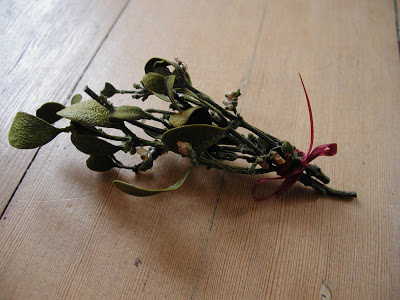Many of us have a little sprig of mistletoe hanging in our doorways this time of year, and perhaps have shared or stolen a kiss beneath this plant. It’s a powerful little plant indeed to draw people together in this way. I have also heard that it is a good plant to have in your home for good fortune this time of year and for keeping away negative energy. If you live near oak trees, you will recognize it as a parasite that grows high up in the branches, staying green long after the oak leaves have fallen. Our local mistletoe (Phoradendron) are actually hemiparasitical (partial parasites) because they cannot photosynthesize on their own. They send a root system into the bark of their host, drawing out nutrients. While a few are not terribly harmful to the trees, I understand understand they can be in large quantities, but they do provide important wildlife habitat for a variety of creatures, including spotted owls. We have several enormous ones up in the crowns of our old oaks. This year I was lucky to have some fall down in a big windstorm. Although most of it was accidentally composted by my husband, I managed to save just enough to hang above the doorway with a little red ribbon.
Like evergreen boughs and holly, this is another plant with a long, rich history found in folklore and mythology. If we look to ancient Norse myths, we find mistletoe is a plant of peace, fertility, and healing. I found this summary of the legend at http://www.mistletoesprigs.com/:
“In Norse mythology, mistletoe is rooted in the myth of Balder, the god of the summer sun.
Balder dreamed he was going to die. His mother, Frigga, became distraught when she heard this and asked the air, fire, water and all the plants and animals to spare her son.
But Loki, the god of evil, found one plant Frigga had overlooked – mistletoe – because it grew neither in the ground nor underground. He made a poison arrow of mistletoe and tricked Balder’s blind brother into shooting Balder.
For three days the earth grew dark. It rained constantly. Frigga cried tears that turned into white berries on the mistletoe plant. When she kissed her dead son, her kiss reversed the mistletoe’s poison, and he came back to life.
She declared that anyone who walked under a tree where mistletoe grew should receive a kiss. Thus mistletoe became a symbol of love.”

So interesting! Down here in the Sonoran Desert, we have desert mistletoe (it grows in palo verdes and mesquite trees)- and the phainopepla (silky flycatchers) use it as their main food source during the winter.
I didn't know about desert mistletoe. There must be different ones in different areas all over the world. I have heard about European mistletoe too, and one troublesome sort here called dwarf mistletoe that is very damaging to trees, but I heard that it also is good food for several species. It's sounding like mistletoe has an imporatnt role to play in the web of life. Thanks for sharing some desert ecology with me!